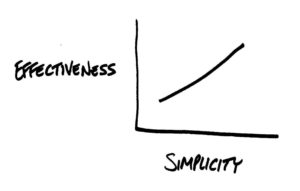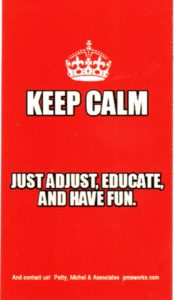“The way we’re running the company, the product design, the advertising– it all comes down to this: let’s make it simple, really simple.” Steve Jobs (Walter Isaacson) 1.
If you could simplify your business even more than it is, you would make more money and have less stress.
There is a direct relationship between simplicity and productivity, and an inverse relationship between complexity and productivity.
The most successful businesses have capitalized on this fact. This was one of Apple computer’s unique selling propositions – to focus on the simple and eliminate what wasn’t essential.
From its inception, the Apple Macintosh computer was designed with simplicity in mind. Other companies have focused on simplicity: McDonalds order via drive-through, Ikea with its simple design, and Amazon with one-click ordering.
Simplicity Pays
Siegal-Gale is an international marketing firm that has studied simplicity in business and has been able to profile and rank businesses according to their simplicity. They call this the Global Brand Simplicity Index and have found that those companies that rank the highest, also outperform companies that rank as more complex. Their report states (2):
- 214% – How much a portfolio of the world’s simplest brands has beaten the average global stock index since 2009
- 69% – The percentage of consumers who are more likely to recommend a brand because it provides simpler experiences and communications
- 63% – The percentage of consumers willing to pay more for simpler experiences
What Does This Mean for Your Practice?
You want to simplify the experience your chiropractic (or other) patient has in your office. From the first phone call, first appointment, examination, report of findings, patient finances, and scheduling, discover ways to simplify your procedures.
Your intake forms may be redundant or complicated, there may be too many rote statements or “scripts” for your staff to say to patients, or there can be extra pathways that your patients have to travel, like so many rabbit trails, where they can get confused and the flow slows down. Staff, or doctors, may have too many decisions to make at each visit.
For example – what extra therapy should the patient receive? Not knowing, I have heard support staff simply ask the patient what therapy they wanted today, as if they were ordering a latte. And as we know, there are definitely too many codes and documentation rules to follow for the doctor. Going total cash is one solution, but intelligent software, dictation, and scribes are other solutions.
Many, if not a majority of the more profitable offices that I have worked with over the years practiced what could be called “straight” chiropractic. The straight practice (no additional modalities) works well, when it does, because its procedures and flow are simple. It is usually more profitable because extra overhead hides in the complicated.
Focus: Eliminate All but The Essential
Steve Jobs again: “People think focus means saying yes to the thing you’ve got to focus on. But that’s not what it means at all. It means saying no to the hundred other good ideas that there are. You have to pick carefully. I’m actually as proud of the things we haven’t done as the things I have done. Innovation is saying no to 1,000 things.”— Steve Jobs, WWDC 199(3)
I am not advocating no supplements, no exercise physiology, no electrical therapy. But to be honest, how much of this gets used in your office? I know offices — right now, and have known hundreds more, that have equipment lying around unused or bottles of vitamins collecting dust on overlooked shelves.
You have to embrace first only those unique outcomes that you can deliver. Work backwards and add only the most critical steps. “Begin with the end in mind”, as Stephen Covey observed in high producers.
For the Chiropractor – Adjust
For a chiropractor, this means adjust. (For other professions: what is your core function?) One of the first doctors I worked with when I moved to Wisconsin in 1988 worked closely with Clarence Gonstead. His license plate read: I ADJUST. He had a full practice, chuckled a lot, and seemed to make a nice living.
Start with this first, and then add additional services carefully – if you want.
Educate – In and Out Of The Office
Secondly, educate. Educate your patients, your team, and your community. But your education has to be simple. Your message has to be concise. One doctor we have worked with over the years has a waiting list practice, with nonstop patient, and even some MD, referrals. He doesn’t do a 4-day report of findings and he doesn’t do a 2-day report of findings on new or reactivated patients.
He just very intently adjusts and talks about the adjustment and what he is adjusting. From there, he then also gets into other health topics such as toxins (vaccinations), nutrition and weight, and exercise.
This is a good model: start with your core service and move out from there. For chiropractic education, you can use simple metaphors like “pinched nerve,” “garden hose,” “rusty gate hinge”, and how the body fighting toxins creates heat (inflammation), etc.
And keep educating your patients with care classes, lending library, table talk, movie nights, special speakers, case histories, and testimonials.
And do this first and continually with your support team. This is not done enough!
One method to discover what to simplify is to regularly practice your procedures. For example, do a rehearsal of what happens when a new patient comes into your office on their first day, 2nd day, 3rd day, etc. You will flush out confusions, redundancies, and extra motions that complicate the patient experience.
Outside of your office, the same applies. Educate your community on what you do. What is your simple selling proposition that people want?
For example, someone asks you “what do you do?”: “Well…
we help to improve your health, we relieve your pain,
and we increase your game – naturally!
No drugs, no surgery, and we guarantee you have fun in the bargain.”
How’s that? A simple and a desirable unique selling proposition (USP). (You can use this in all your marketing communications – no charge!)
Make it Fun – and Have Fun
Lastly, there is fun. You can and should have fun doing this. And so should your patients and support crew.
Patients will mostly remember how they feel after leaving your office. Was it a pleasant, enjoyable experience? Was it fun?
Practice life can often bring about a kind of serious hue over the office. Administrative errors, missed appointments, a dissatisfied patient, a staff member out for the day, too many bills – all of this can create an extra layer of anxiety or seriousness in the office.
Fight this by being grateful for all the wonderful outcomes of your patients. Work on having a “the gratitude attitude.”
And as you simplify your processes, you will find that everyone’s attention becomes freer to enjoy helping each other — to help the patients.
Simple is more fun and profitable.
So here is a question for you: Which comes first, the fun or the smile?
Well, you can kick things off right now… right now with a smile. Actually, smiling is simpler and requires less muscles than frowning.
Frowning is complex, so start right now by smiling.
Try it.
See? Already your business and life is simpler and better – and funner.
-Ed
(To help you keep things simple, you can order two magnets of the above image for your office, courtesy of PM&A while quantities last. Click here to order. We will mail them to you at no charge.)
- Steve Jobs (Walter Isaacson)
- http://simplicityindex.com/
- YouTube https://www.youtube.com/watch?v=GnO7D5UaDig
For a printable copy of this article click [The Power of Simplicity]


